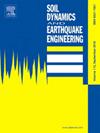Convolutional autoencoder-based ground motion clustering and selection
IF 4.2
2区 工程技术
Q1 ENGINEERING, GEOLOGICAL
引用次数: 0
Abstract
Ground motion selection has become increasingly central to the assessment of earthquake resilience. The selection of ground motion records for use in nonlinear dynamic analysis significantly affects structural response. This, in turn, will impact the outcomes of earthquake resilience analysis. This paper presents a new ground motion clustering algorithm, which can be embedded in current ground motion selection methods to properly select representative ground motion records that a structure of interest will probabilistically experience. The proposed clustering-based ground motion selection method includes four main steps: 1) leveraging domain-specific knowledge to pre-select candidate ground motions; 2) using a convolutional autoencoder to learn low-dimensional underlying characteristics of candidate ground motions’ response spectra – i.e., latent features; 3) performing k-means clustering to classify the learned latent features, equivalent to cluster the response spectra of candidate ground motions; and 4) embedding the clusters in the conditional spectra-based ground motion selection. The selected ground motions can represent a given hazard level well (by matching conditional spectra) and fully describe the complete set of candidate ground motions. Three case studies for modified, pulse-type, and non-pulse-type ground motions are designed to evaluate the performance of the proposed ground motion clustering algorithm (convolutional autoencoder + k-means). Considering the limited number of pre-selected candidate ground motions in the last two case studies, the response spectra simulation and transfer learning are used to improve the stability and reproducibility of the proposed ground motion clustering algorithm. The results of the three case studies demonstrate that the convolutional autoencoder + k-means can 1) achieve 100 % accuracy in classifying ground motion response spectra, 2) correctly determine the optimal number of clusters, and 3) outperform established clustering algorithms (i.e., autoencoder + k-means, time series k-means, spectral clustering, and k-means on ground motion influence factors). Using the proposed clustering-based ground motion selection method, an application is performed to select ground motions for a structure in San Francisco, California. The developed user-friendly codes are published for practical use.
求助全文
约1分钟内获得全文
求助全文
来源期刊

Soil Dynamics and Earthquake Engineering
工程技术-地球科学综合
CiteScore
7.50
自引率
15.00%
发文量
446
审稿时长
8 months
期刊介绍:
The journal aims to encourage and enhance the role of mechanics and other disciplines as they relate to earthquake engineering by providing opportunities for the publication of the work of applied mathematicians, engineers and other applied scientists involved in solving problems closely related to the field of earthquake engineering and geotechnical earthquake engineering.
Emphasis is placed on new concepts and techniques, but case histories will also be published if they enhance the presentation and understanding of new technical concepts.
 求助内容:
求助内容: 应助结果提醒方式:
应助结果提醒方式:


